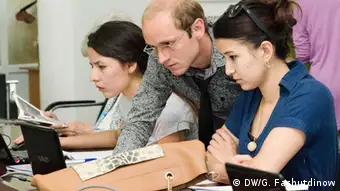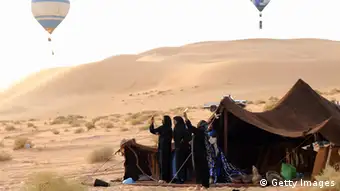Insights
Helping young people understand the news
Being able to interpret and use information is vital in today's digital world. #mediadev talks to the World Association of Newspapers about how it helps support media and information literacy projects worldwide.
The World Association of Newspapers and News Publishers (WAN-IFRA) helps publishers worldwide create partnerships with local schools and education authorities to strengthen media and information literacy skills among young people. As part of its work, it also awards a yearly prize to news publishers who excel in engaging those under 25.
Media and information literacy (MIL) is considered an essential skill to have in today's information societies. MIL refers to the ability to access, understand and critically evaluate information and media messages from a variety of sources. It includes creating media and learning how to use information in an ethnical manner.
Aralynn McMane is the Executive Director of Youth Engagement and News Literacy at WAN-IFRA. She discusses with #mediadev how media and information literacy is evolving, how mobile phones are decreasing the differences between countries and why she loves her job so much.
#mediadev: What is different about WAN-IFRA's media and information literacy engagement in these increasingly digital times?
Aralynn McMane: We try to be very platform agnostic, emphasizing the core values and practices that apply to creating, consuming and sharing news. It's also a lot about encouraging publishers to interact with young people as normal human beings.
Is this interaction in the interest of the news publishers?
It's in everybody's interest. Young people can learn about the differences between journalism and other content and also learn journalism skills in order to judge other content. For their part, news publishing staff can then more readily interact with young people, getting more quickly past the stereotypes.
How has media and information literacy evolved over the past ten years?

"After you provide both news people and teachers with the basics, they adapt what they need and dump the rest"
There is an interesting evolution in my own work. In 2008, we asked a researcher to do a report based on a study he did. It was an experiment with US university students who had done a media literacy course, the goal of which was to enable them to become critical consumers of news and learn to appreciate the role of journalism and democracy. The students learned to be critical – they learned to deconstruct media messages – no problem. But they also became more cynical about the role of journalism in a democracy and that was shocking to me. I think if you are not careful, the trappings of media and information literacy can prevent a healthy understanding of the role of journalism in supporting democracies or the movement toward them.
What aspects of media and information literacy does WAN-IFRA focus on?
We concentrate mostly on news literacy. For us, that's helping citizens, especially children and teenagers, understand, value and participate in 21st century journalism in a democracy as they analyze all kinds of content, most effectively through a journalistic prism. I especially like that the approach encourages everybody to examine their biases, including the consumer. That said, all aspects of MIL tend to come up at some point. For example, we routinely encourage and recognize work in information literacy, especially around basic reading skills at the local level.
How does WAN-INFRA work, for example, in an African country. How do you start a MIL project?
In all countries, we wait until somebody asks for help in creating a school-publisher partnership of some sort. Usually that comes from a news executive who is inspired by what is happening elsewhere. In the past, the partnership emerged around using printed newspapers in schools, which publishers donated – perhaps getting sponsorship at some point. We've found teachers to be very receptive and hugely creative when it comes to the basic activity of using the news for all kinds of topics, including MIL. That's usually the easy part because when you train five teachers, if they find it useful in their everyday work, an innovation multiplier effect kicks in and nobody needs further training from outside. I've seen that happen all over the world, and among teachers with many reasons to not want to deal with more to do.
If the time seems right, we help get a group of publishers on board to work together and also help approach education ministries to set up a national program. Now, our focus has moved from using the news in class to digital news literacy and giving young people a taste of doing journalism. In June, we will begin to work with the publishers' association and teachers in Colombia who long have used the news (mostly printed newspapers) in class to assess activities about judging all information, especially online, like a reporter would.
Are your MIL projects different depending on the region they are running in?
Surprisingly not very much, at least for the practical bits. We've found that after you provide both news people and teachers with the basics, they adapt what they need and dump the rest. More than once, I have thought a strategy someone was describing to a group could never work in that particular context and found out six months later that they had invented a variation that worked just fine. You show the options, and they pick and develop the best from what's on offer.
I must say, though, that our ideal situation for youth engagement is to present a best practice model from somewhere similar but which is a bit further down the road from what they are doing. Then we have an ideathon for people to dream up something they can try without the need for a lot of permissions from above.
There are some places where basic freedom of expression – a core of this work for us – simply doesn't fly, so that requires a different approach.
We only do development or youth engagement work in these countries in exceptional circumstances. For example, one of our Golden Pen of Freedom laureates, Doan Viet Hoat, spent 22 years in Vietnamese prisons. After an international campaign, he was released and deported. Astonishingly, he asked us to set up an executive development program with the Vietnamese Journalists Association. I hope for a subtle but long-term impact there.
China is another tricky case. We did MIL work there using news in English education. This had clear benefits in that there was no translator to mask or code what was said. Encouraging access to English-language, non-Chinese journalism was an obvious teaching strategy.
However, because I've seen media literacy hijacked by governments who omit the freedom of expression part, I prefer to work in at least nominal democracies where the results can be immediate. Apart from the political circumstances, I think places have more similarities than differences these days.
In what way?
If I have learned anything in my career, it is that ideas are more transferable than you think they are. Wherever you give a group of motivated people a core of ideas, they are very resourceful in adapting them. That said, I have also found that the closer the source of the ideas, the better. We find an idea is implemented faster somewhere like Liberia if the expertise comes from Uganda, which has a similar history, rather than from, say, Sweden.
Also, in terms of digital news literacy, the similarities are enormous. Cellphones tend to be everywhere, even in countries like Liberia. I've been in Liberian classrooms where newspapers are the only printed resource they have. But cellphones were all over the place, despite depending on generators to charge them.
What makes you personally passionate about working in MIL?
I love it because the people I work with are all about solutions. I get to work with people from news publisher organizations who are committed to young people, so automatically they are people looking to the future. They, and the teachers they work with, are often on the cutting edge of creating new ways do to things. And the teachers, of course, are massively inspirational. I have the best job in my organization.
This interview has been edited for brevity and clarity.
DW recommends
WWW links
- Date 25.05.2016
- Author Vera Möller-Holtkamp
- Feedback: Send us an e-mail. Please include your name and country in your reply.
- Print Print this page
- Permalink https://p.dw.com/p/1Itg6
- Date 25.05.2016
- Author Vera Möller-Holtkamp
- Send us your feedback.
- Print Print this page
- Permalink https://p.dw.com/p/1Itg6



